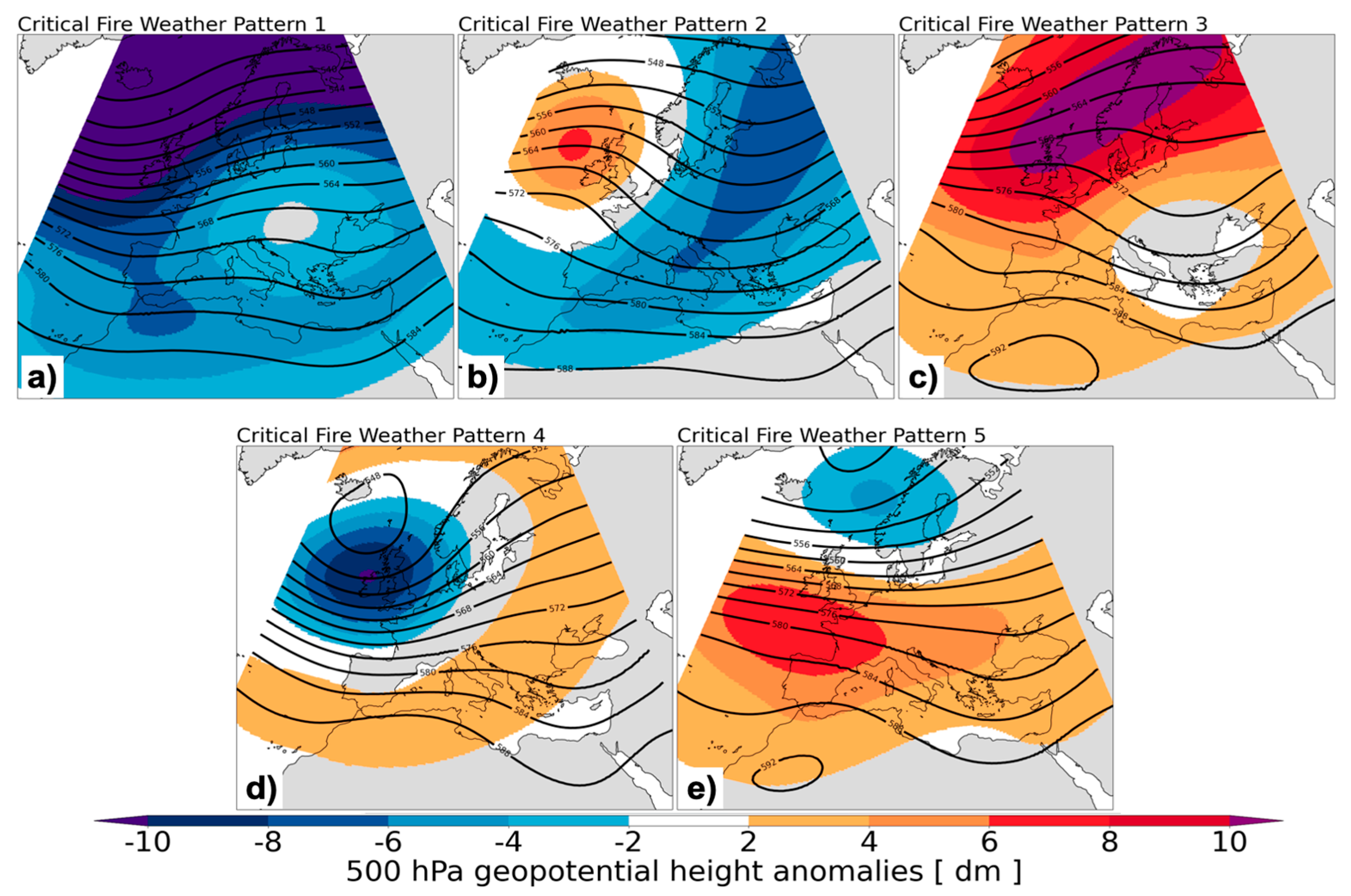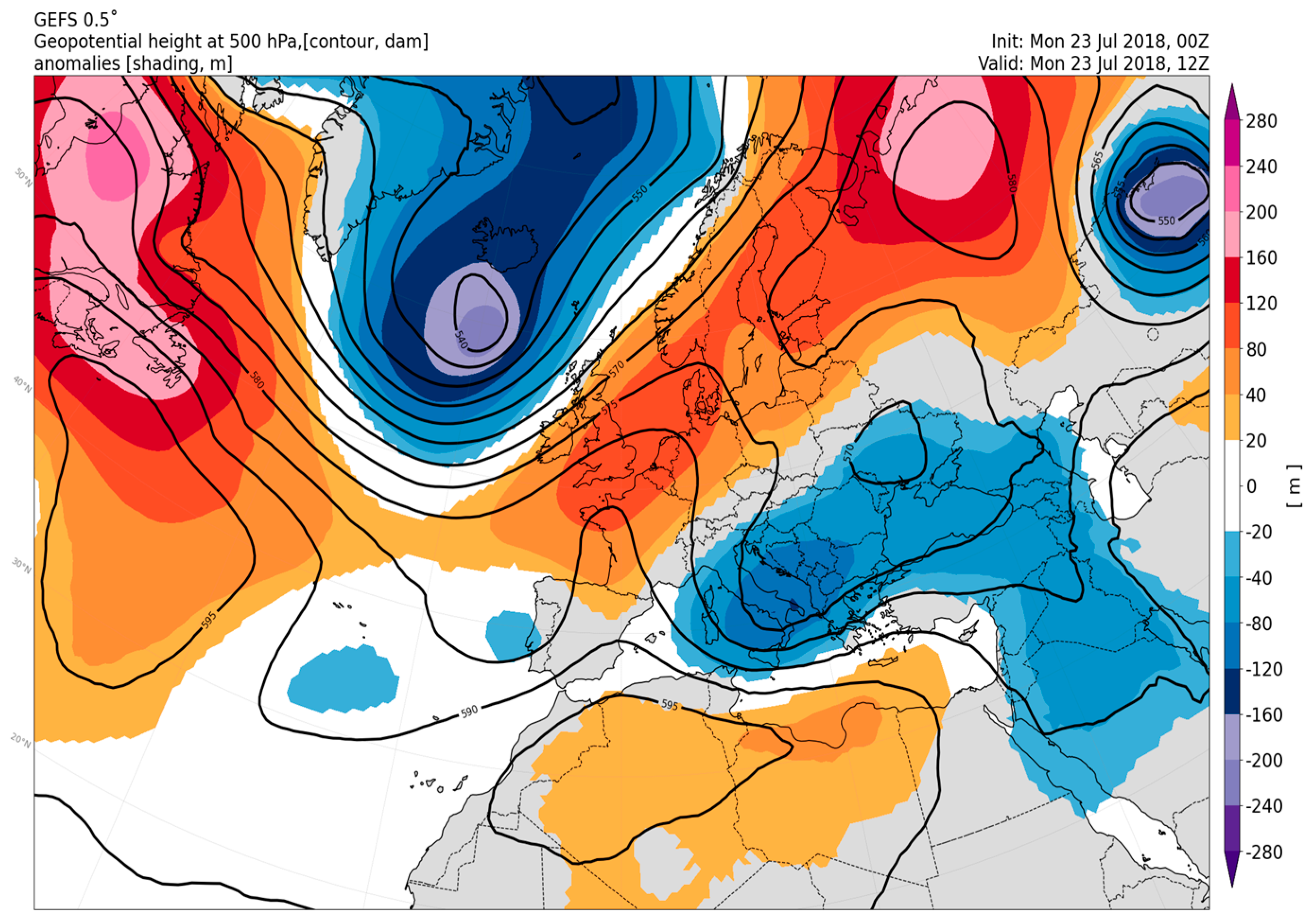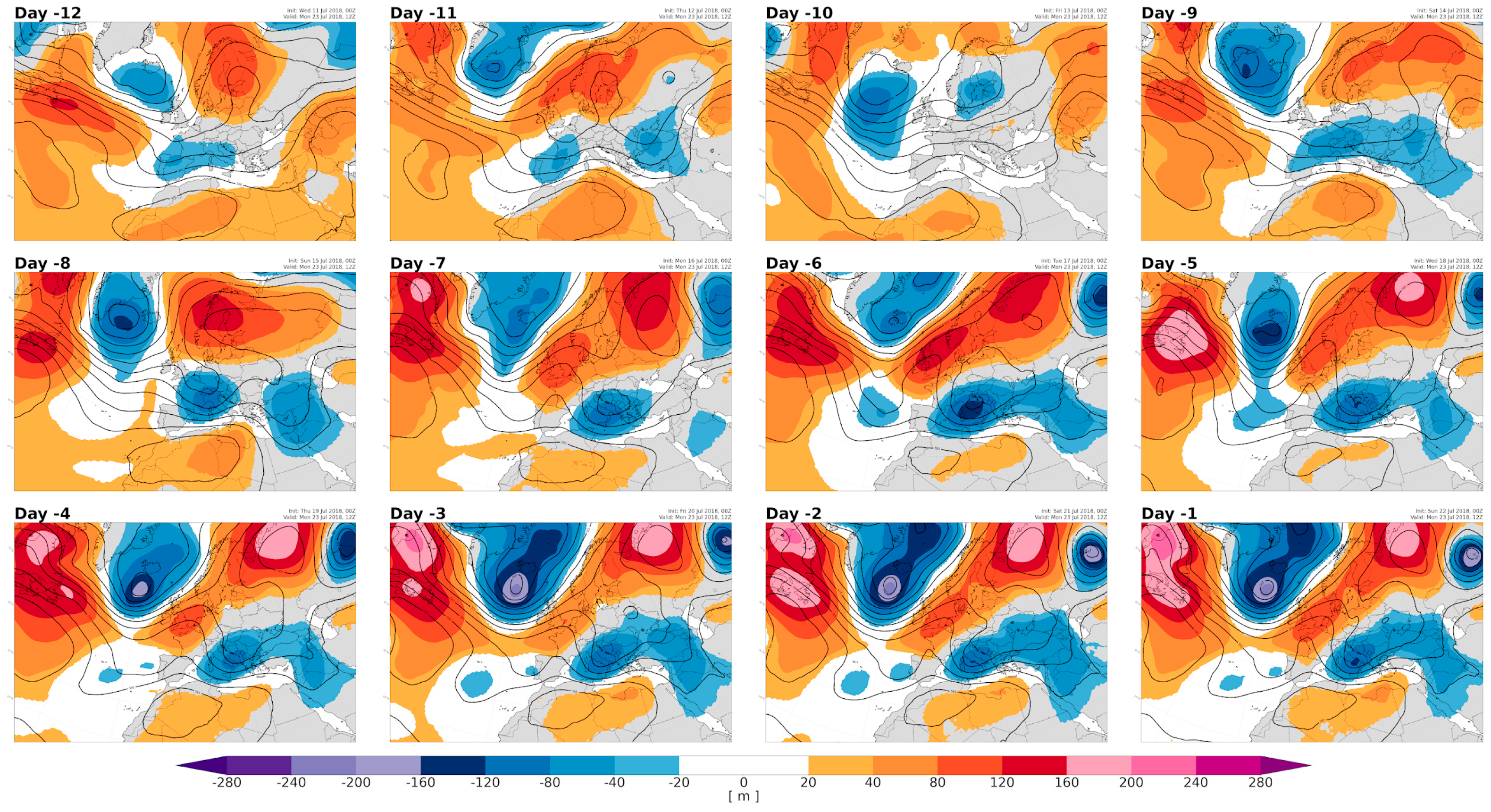The Predictability of the Synoptic-Scale Fire Weather Conditions during the 2018 Mati Wildfire †
Abstract
:1. Introduction
2. Data and Methods
2.1. Atmospheric Data and Classification of Weather Patterns
2.2. GEFS Reforecasts
3. Results
3.1. Critical Fire Weather Patterns of Greece
3.2. Synoptic-Scale Fire Weather Conditions during the 2018 Mati Wildfire
3.3. Predictability of the Synoptic-Scale Fire Weather Conditions during the 2018 Mati Wildfire
4. Conclusions
Author Contributions
Funding
Data Availability Statement
Conflicts of Interest
References
- Pausas, J.G.; Vallejo, V.R. The Role of Fire in European Mediterranean Ecosystems; Springer: Berlin/Heidelberg, Germany, 1999; pp. 3–16. [Google Scholar]
- Keeley, J.E.; Bond, W.J.; Bradstock, R.A.; Pausas, J.G.; Rundel, P.W. Fire in Mediterranean Ecosystems: Ecology, Evolution and Management; Cambridge University Press: Cambridge, UK, 2011. [Google Scholar]
- Duane, A.; Castellnou, M.; Brotons, L. Towards a comprehensive look at global drivers of novel extreme wildfire events. Clim. Chang. 2021, 165, 43. [Google Scholar] [CrossRef]
- Flannigan, M.; Wotton, B. Climate, weather, and area burned. In Forest Fires; Academic Press: Cambridge, MA, USA, 2001; pp. 351–373. [Google Scholar]
- Schroeder, M.J. Critical Fire Weather Patterns in the Conterminous United States; Environmental Science Services Administration: Rockville, MD, USA, 1969. [Google Scholar]
- Skinner, W.R.; Stocks, B.J.; Martell, D.L.; Bonsal, B.; Shabbar, A. The association between circulation anomalies in the mid-troposphere and area burned by wildland fire in Canada. Theor. Appl. Climatol. 1999, 63, 89–105. [Google Scholar] [CrossRef]
- Crimmins, M.A. Synoptic climatology of extreme fire-weather conditions across the southwest United States. Int. J. Climatol. 2006, 26, 1001–1016. [Google Scholar] [CrossRef]
- Pereira, M.G.; Trigo, R.M.; da Camara, C.C.; Pereira, J.M.; Leite, S.M. Synoptic patterns associated with large summer forest fires in Portugal. Agric. For. Meteorol. 2005, 129, 11–25. [Google Scholar] [CrossRef]
- Carmo, M.; Ferreira, J.; Mendes, M.; Alvaro Silva Silva, P.; Alves, D.; Reis, L.; Novo, I.; Viegas, D.X. The climatology of extreme wildfires in Portugal, 1980–2018: Contributions to forecasting and preparedness. Int. J. Climatol. 2022, 42, 3123–3146. [Google Scholar] [CrossRef]
- Hayasaka, H.; Tanaka, H.L.; Bieniek, P.A. Synoptic-scale fire weather conditions in Alaska. Polar Sci. 2016, 10, 217–226. [Google Scholar] [CrossRef]
- Paschalidou, A.; Kassomenos, P. What are the most fire-dangerous atmospheric circulations in the eastern-mediterranean? analysis of the synoptic wildfire climatology. Sci. Total Environ. 2016, 539, 536–545. [Google Scholar] [CrossRef] [PubMed]
- Lagerquist, R.; Flannigan, M.D.; Wang, X.; Marshall, G.A. Au-tomated prediction of extreme fire weather from synoptic patterns in northern Alberta, Canada. Can. J. For. Res. 2017, 47, 1175–1183. [Google Scholar] [CrossRef]
- Rodrigues, M.; González-Hidalgo, J.C.; Peña-Angulo, D.; Jiménez-Ruano, A. Identifying wildfire-prone atmospheric circulation weather types on mainland Spain. Agric. For. Meteorol. 2019, 264, 92–103. [Google Scholar] [CrossRef]
- Zhong, S.; Yu, L.; Heilman, W.E.; Bian, X.; Fromm, H. Synoptic weather patterns for large wildfires in the northwestern United States—A climatological analysis using three classification methods. Theor. Appl. Climatol. 2020, 141, 1057–1073. [Google Scholar] [CrossRef]
- Haines, D.A. A lower atmosphere severity index for wildlife fires. Natl. Weather. Dig. 1988, 13, 23–27. [Google Scholar]
- Werth, P.A.; Potter, B.E.; Alexander, M.E.; Clements, C.B.; Cruz, M.G.; Finney, M.A.; Forthofer, J.M.; Goodrick, S.L.; Hoffman, C.; Jolly, W.M.; et al. Synthesis of Knowledge of Extreme Fire Behavior: Volume 2 for Fire Behavior Specialists, Researchers, and Meteorologists; U.S. Department of Agriculture, Forest Service, Pacific Northwest Research Station: Portland, OR, USA, 2016.
- Potter, B.E. Atmospheric interactions with wildland fire behaviour–i. basic surface interactions, vertical profiles and synoptic structures. Int. J. Wildland Fire 2012, 21, 779. [Google Scholar] [CrossRef]
- Peterson, D.A.; Hyer, E.J.; Campbell, J.R.; Solbrig, J.E.; Fromm, M.D. A conceptual model for development of intense pyrocumulonimbus in western north America. Mon. Weather Rev. 2017, 145, 2235–2255. [Google Scholar] [CrossRef]
- Giannaros, T.M.; Papavasileiou, G.; Lagouvardos, K.; Kotroni, V.; Dafis, S.; Karagiannidis, A.; Dragozi, E. Meteorological analysis of the 2021 extreme wildfires in greece: Lessons learned and implications for early warning of the potential for pyroconvection. Atmosphere 2022, 13, 475. [Google Scholar] [CrossRef]
- Diakakis, M.; Xanthopoulos, G.; Gregos, L. Analysis of forest fire fatalities in greece: 1977–2013. Int. J. Wildland Fire 2016, 25, 797. [Google Scholar] [CrossRef]
- Koutsias, N.; Arianoutsou, M.; Kallimanis, A.S.; Mallinis, G.; Halley, J.M.; Dimopoulos, P. Where did the fires burn in Peloponnisos, Greece the summer of 2007? evidence for a synergy of fuel and weather. Agric. For. Meteorol. 2012, 156, 41–53. [Google Scholar] [CrossRef]
- Lagouvardos, K.; Kotroni, V.; Giannaros, T.M.; Dafis, S. Meteoro- logical conditions conducive to the rapid spread of the deadly wildfire in eastern Attica, Greece. Bull. Am. Meteorol. Soc. 2019, 100, 2137–2145. [Google Scholar] [CrossRef]
- Hersbach, H.; Bell, B.; Berrisford, P.; Hirahara, S.; Horányi, A.; Muñoz-Sabater, J.; Nicolas, J.; Peubey, C.; Radu, R.; Schepers, D.; et al. The era5 global reanalysis. Q. J. R. Meteorol. Soc. 2020, 146, 1999–2049. [Google Scholar] [CrossRef]
- Kohonen, T. Self-Organizing Maps; Springer: Berlin/Heidelberg, Germany, 2001; Volume 30. [Google Scholar]
- Papavasileiou, G.; Giannaros, M.T. Synoptic-scale drivers of fire weather in Greece. Agric. For. Meteorol 2023. under review. [Google Scholar]



Disclaimer/Publisher’s Note: The statements, opinions and data contained in all publications are solely those of the individual author(s) and contributor(s) and not of MDPI and/or the editor(s). MDPI and/or the editor(s) disclaim responsibility for any injury to people or property resulting from any ideas, methods, instructions or products referred to in the content. |
© 2023 by the authors. Licensee MDPI, Basel, Switzerland. This article is an open access article distributed under the terms and conditions of the Creative Commons Attribution (CC BY) license (https://creativecommons.org/licenses/by/4.0/).
Share and Cite
Papavasileiou, G.; Giannaros, T.M. The Predictability of the Synoptic-Scale Fire Weather Conditions during the 2018 Mati Wildfire. Environ. Sci. Proc. 2023, 26, 164. https://doi.org/10.3390/environsciproc2023026164
Papavasileiou G, Giannaros TM. The Predictability of the Synoptic-Scale Fire Weather Conditions during the 2018 Mati Wildfire. Environmental Sciences Proceedings. 2023; 26(1):164. https://doi.org/10.3390/environsciproc2023026164
Chicago/Turabian StylePapavasileiou, Georgios, and Theodore M. Giannaros. 2023. "The Predictability of the Synoptic-Scale Fire Weather Conditions during the 2018 Mati Wildfire" Environmental Sciences Proceedings 26, no. 1: 164. https://doi.org/10.3390/environsciproc2023026164
APA StylePapavasileiou, G., & Giannaros, T. M. (2023). The Predictability of the Synoptic-Scale Fire Weather Conditions during the 2018 Mati Wildfire. Environmental Sciences Proceedings, 26(1), 164. https://doi.org/10.3390/environsciproc2023026164






